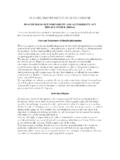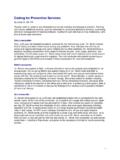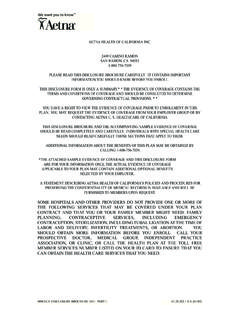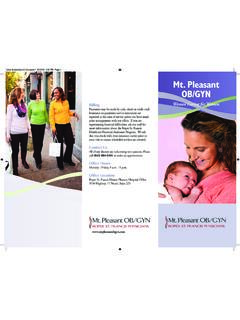Transcription of (HE4 EIA + ARCHITECT CA125 II™) Prod. No. 404 …
1 1 ROMA (HE4 EIA + ARCHITECT CA125 II )Prod. No. 404-10 USInstructions for use. 2011-09 PRECAUTION: ROMA (HE4 EIA + ARCHITECT CA 125 II) should not be used without an independent clinical /radiological evaluation and is not intended to be a screening test or to determine whether a patient should proceed to surgery. Incorrect use of ROMA (HE4 EIA + ARCHITECT CA 125 II) carries the risk of unnecessary testing, surgery, and/or delayed USEFor In Vitro Diagnostic Use Risk of Ovarian Malignancy Algorithm (ROMA ) is a qualitative serum test that combines the results of HE4 EIA, ARCHITECT CA 125 II and menopausal status into a numerical is intended to aid in assessing whether a premenopausal or postmeno-pausal woman who presents with an ovarian adnexal mass is at high or low likeli-hood of finding malignancy on surgery. ROMA is indicated for women who meet the following criteria: over age 18; ovarian adnexal mass present for which surgery is planned, and not yet referred to an oncologist.
2 ROMA must be interpreted in conjunction with an independent clinical and radiological assessment. The test is not intended as a screening or stand-alone diagnostic INFORMATION PERFORMINGTHE ASSAY ALWAYS REFERTO PACKAGE INSERTSUPPLIEDWITH THE KIT2 SUMMARY AND EXPLANATION OF THE ASSAYThe Risk of Ovarian Malignancy Algorithm (ROMA ) is a qualitative serum test combining the results of HE4 EIA, ARCHITECT CA 125 II and menopausal status into a numerical score. ROMA was developed in a training set using separate logistic regression equations for premenopausal and postmenopausal women:Premenopausal woman:Predictive Index (PI) = + *LN[HE4] + *LN[CA 125]Postmenopausal woman:Predictive Index (PI) = + *LN[HE4] + *LN[CA 125]ROMA = exp(PI) / [1 + exp(PI)] *10 ROMA is used to stratify women into likelihood groups for finding cancer on sur-gery. In order to provide a specificity level of 75%, a cut point of was used for premenopausal women and was used for postmenopausal women who present with an ovarian adnexal mass.
3 Women with ROMA results above these cut points is at high likelihood of finding malignancy on HE4 EIA is an enzyme immunometric assay for the quantitative determination of human epididymis protein 4 (HE4) in human serum. ROMA can only be used with the HE4 EIA assay value obtained from the manual HE4 EIA method from Fujirebio Diagnostics. The ARCHITECT CA 125 II assay is a chemiluminescent Microparticle immu-noassay (CMIA) for the quantitative determination of OC 125 defined antigen in human serum and plasma on the ARCHITECT i System. ROMA can only be used with the ARCHITECT CA125 II assay value obtained from ARCHITECT and CA125 are detected in elevated concentrations in serum from women with ovarian cancer. In a case/control study comparing patients with ovarian cancer to healthy and benign conditions, Hellstr m et al. found that HE4 detected ovarian cancer with 67% sensitivity at a specificity level of 96% (1). The authors concluded that the sensitivity of the HE4 is comparable to that of CA125 , but that HE4 is less frequently elevated in women with nonmalignant disease.
4 In a study by Moore et al., evaluating nine known biomarkers for ovarian cancer, HE4 showed the highest sensitivity for the detection of ovarian cancer, particularly in early stage disease. In this study, the combination of HE4 and CA 125 was a more accurate predictor of malignancy than either marker alone, with a sensitivity of 76% and a specificity of 95% (2). A study by Montagnana et al. assessed serum levels of both HE4 and CA125 in healthy controls and in patients diagnosed with a malignant pelvic mass and revealed that HE4 had a significantly higher area under the curve than CA125 ( vs. ) with a sensitivity and specificity of 98 and 100%, respectively (3). Huhtinen et al. reported that serum concentration of HE4 was significantly higher in patients with endometrial and ovarian cancer than in patients with ovarian endometriomas or other types of endometriosis (4). A study by Montagnana et al. confirmed that HE4 has a significantly higher area under the curve compared to 3CA125 for differentiating ovarian cancer from ovarian endometriomas (5).
5 These studies suggest that HE4 is valuable for discriminating ovarian cancers from benign ovarian masses. Several studies have indicated that using HE4 alone or including HE4 in multivariate analysis of ovarian cancer likelihood may improve the accuracy for detection of ovarian cancer at an earlier stage (3, 6-12). Ovarian cancer is the fourth most common cause of cancer-related death in women worldwide. In the United States, annual incidence is about 25,000 with an annual mortality of 14,000 (13). The symptoms of ovarian cancer are related to the presence of adenxal masses and are often vague and unspecific. The primary goal of diagnostic evaluation of an adnexal mass is to determine whether it is benign or malignant. It is estimated that 5 to 10 percent of women in the United States will undergo a surgical procedure for a suspected ovarian neoplasm during their lifetime, and 13 to 21 percent of these women will be found to have an ovarian malignancy (13). The American College of Obstetricians and Gynecologists Practice Bulletin published in 2007 states the following Women with ovarian cancer whose care is managed by physicians who have advanced training and expertise in the treatment of women with ovarian cancer, such as gynecologic oncologists, have improved overall survival rates compared with those treated without such collaboration.
6 (14). Since the majority of adnexal masses are benign, it is important to determine preoperatively whether a patient is at high likelihood for ovarian malignancy, in order to ensure proper management (14). Since the initial report in 1988, clinical impres-sion, serum CA125 and ultrasound along with CT scan, MRI and CT/PET have been the standards in the determination of whether an adnexal mass is suspicious for malignancy (15). Although the literature is replete with papers describing which modality is the more accurate, the combination of physical examination, CA125 and imaging affords the highest positive predictive value (16-18). To improve the management of patients presenting with adnexal mass, the results of HE4 EIA may be used in conjunction with the results of ARCHITECT CA 125 II as an aid in assessing the likelihood of finding malignancy on surgery in premenopausal and postmenopausal women presenting with an adnexal mass. An additional use of the HE4 EIA is as an aid in monitoring recurrence or progressive disease in patients with epithelial ovarian cancer (8, 19).
7 The results should be used in conjunction with other clinical methods used for monitoring ovarian OF THE TESTThe HE4 EIA is an enzyme immunometric assay for the quantitative determination of HE4 in human serum. The HE4 EIA is a solid-phase, non-competitive immunoassay based upon the direct sandwich technique using two mouse monoclonal antibod-ies, 2H5 and 3D8, directed against two epitopes in the C-WFDC domain of HE4. Calibrators, controls and patient samples are incubated together with biotinylated Anti-HE4 monoclonal antibody (MAb) 2H5 in streptavidin coated microstrips. HE4 present in calibrators or samples is adsorbed to the streptavidin coated microstrips by the biotinylated Anti-HE4 MAb during the incubation. The strips are then washed and incubated with HRP labeled Anti-HE4 MAb 3D8. After washing, buffered Sub-strate/Chromogen reagent (hydrogen peroxide and 3, 3 , 5, 5 tetra-methyl-benzidine) is added to each well and the enzyme reaction is allowed to proceed. During the enzyme reaction a blue color will develop if antigen is present.
8 The intensity of the color is proportionate to the amount of HE4 present in the samples. The color intensity is determined in a microplate spectrophotometer at 620 nm (or optionally at 405 nm after addition of Stop Solution).The ARCHITECT CA 125 II assay is a chemiluminescent Microparticle immunoas-say (CMIA) for the quantitative determination of OC 125 defined antigen in human serum and plasma on the ARCHITECT i2000SR System1. The ARCHITECT CA 125 II assay is a two-step immunoassay to determine the presence of OC 125 defined antigen in human serum and plasma, using CMIA technology with flexible assay protocols, referred to as Chemiflex. In the first step, sample and OC 125 coated paramagnetic microparticles are combined. OC 125 defined antigen present in the sample binds to the OC 125 coated microparticles. After washing, M11 acridinium-labeled conjugate is added in the second step. Pre-Trigger and Trigger Solutions are then added to the reaction mixture; the resulting chemiluminescent reaction is measured as relative light units (RLUs).
9 A direct relationship exists between the amount of OC 125 defined antigen in the sample and the RLUs detected by the ARCHITECT i2000SR optical (HE4 EIA + ARCHITECT CA 125 II) has been validated for use on the ARCHITECT i2000SR system for the CA 125 testing used in the ROMA equation. Other ARCHITECT i System platforms have not been validated for ROMA Risk of Ovarian Malignancy Algorithm (ROMA ) is a qualitative serum test that combines the results of HE4 EIA, ARCHITECT CA125 II and menopausal status into a numerical score. Refer to the Calculation of Results section of this package AND PRECAUTIONSFor In Vitro Diagnostic Use: For professional use only Follow the instructions in the package inserts for HE4 EIA and ARCHITECT CA 125 II, respectively. Reliability of assay results cannot be guaranteed if there are any deviations from the instructions in the package EIA KIT STORAGE AND HANDLINGFor detailed instructions on HE4 EIA Kit storage and handling including specific instructions for all kit components, refer to the package insert.
10 When stored and handled as directed, the HE4 EIA Kit is stable until the expiration date stated on the label outside of the kit box. Do not use the HE4 EIA Kit beyond the expiration date. The HE4 EIA Kit must be stored at 2-8 C. Do not freeze. Return to 2-8 C immediately after use. The HE4 EIA Kit reagents should be allowed to reach room temperature (20 25 C) prior to use. Do not mix identical reagents from kits having different lot CA 125 II KIT STORAGE AND HANDLINGFor detailed instructions on ARCHITECT CA 125 II Kit storage and handling including specific instructions for all kit components, refer to the package inserts. When stored and handled as directed, ARCHITECT CA 125 II Kits are stable until the expiration date stated on the label outside of the kit box. Do not use ARCHITECT CA 125 II Kits beyond the expiration date. The ARCHITECT CA 125 II Kits must be stored at 2-8 C and may be used immediately after removal from 2-8 C storage.






